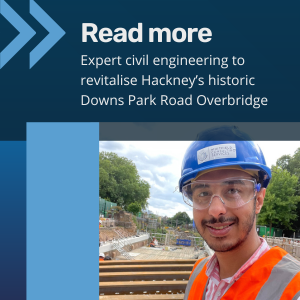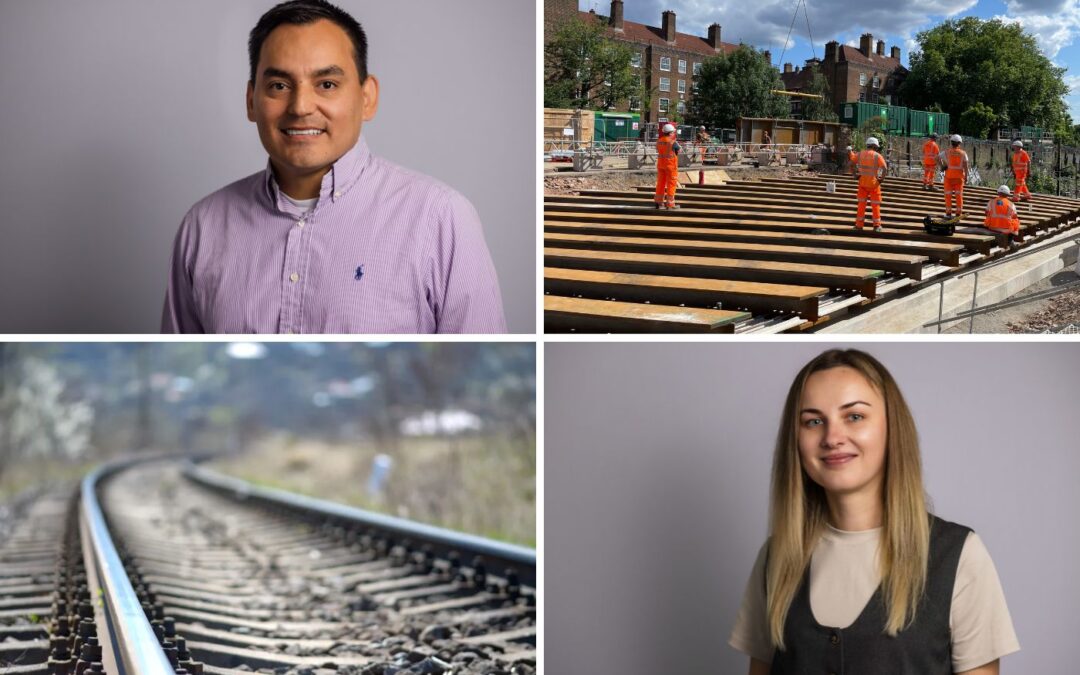The railway sector is entering a critical phase of investment, driven by the urgent need to upgrade ageing infrastructure, strengthen climate change resilience, and decarbonise rail transport systems. Plans laid out under the Network Rail’s Control Period 7 (CP7), and the island of Ireland’s All-Island Strategic Rail Review (AISRR) set out clear visions to modernise our infrastructure.
However, how we achieve these ambitious goals is just as important as the outcomes themselves. Construction and building operations are responsible for around 42% of global carbon emissions, so it’s crucial that every project going forward is designed and built with minimal environmental impact.
By embracing sustainable practices in life cycle assessments, material selection, and construction techniques, civil engineers can reduce a project’s carbon footprint significantly. Let’s explore in more depth.
Calculating carbon costs and undertaking life cycle assessments
One of the key components of sustainable engineering is the life cycle assessment. This ensures that every stage of a project—from planning and design to construction, maintenance, and eventual decommissioning—prioritises reducing the overall environmental footprint. This approach includes careful consideration of the asset’s maintenance, durability, decommissioning, and recyclability for longer-term sustainable outcomes. Throughout a project’s life cycle, engineers should evaluate and update their carbon footprint calculations, utilising evolving information and design insights.
If carbon costs are assessed alongside financial costs at the feasibility assessment stage, the potential for a sustainable solution emerging is maximised. On every project, our engineers complete carbon cost calculations at this stage to help further decision-making throughout the project team.
“On some projects, our calculations mean we are able to challenge the assumed scope,” says Dr Natalja Petkune, Engineering Manager at Whitfield Consulting Services (WCS).
“For example, when working on buildings and other structures that form part of the railway, with which we are very familiar, we might be able to propose smaller structures than assumed because of efficiency of space use, or the strengthening of something existing instead of the creation of a whole new building.” These approaches can reduce the new resources used or reuse existing structures, leading to savings in embodied carbon compared to building a whole new or larger building.
Continued use of existing structures may require measures to extend asset life or strengthen them. Formal compliance verification is essential.
Material selection and the circular economy
Carbon costs can be reduced by specifying sustainable materials. Prioritising reduce and reuse underlines the value of choosing the more sustainable materials, and why this is a vital aspect of sustainable civil engineering.
“If we consider reusing reclaimed materials in a new structure, we can assess compliance using our materials database,” says Natalja. Other sustainable options include crushing reclaimed concrete for road surfacing. Carbon costs can also be reduced by specifying sustainable raw materials. The WCS team recently assessed ECOpact sustainable concrete from Aggregate Industries, which uses cement alternatives like alkali activators.
Civil engineers should prioritise the use of recycled, reclaimed, or low-carbon materials whenever possible. This approach supports the principles of a circular economy, where materials are reused and recycled rather than discarded.
Learn more about supporting the transition to sustainable construction and a circular economy.
Construction techniques and choices
Reducing waste and reusing materials on-site is crucial for sustainable construction. Engineers must be mindful of how materials are used and find ways to minimise waste during the building process.
We employ construction techniques that maximise the use of existing resources, thereby reducing the need for new materials and the waste generated during construction.
Ricardo Villamil, Senior Civil Design Engineer at WCS, shares his insights:
“Technology has enabled us to better understand and utilise existing resources, promoting reuse rather than constant expansion. Rather than solely focusing on introducing new materials and products, I believe in using technology to preserve and make the most of what we already have.”
For example, on the Piccadilly Line upgrade project, we used Ferroscanning to assess the existing floor slabs and determine whether they are likely to be able to withstand the new equipment to be placed there.
“Where possible we are prioritising strengthening existing structures rather than opting for complete demolition and reconstruction. By doing so, we not only reduce waste but also enhance the existing infrastructure,” adds Ricardo.
Learn more about Ricardo and his approach to mastering complex engineering projects
Sustainable decisions in action: Downs Park Road Overbridge project
The Downs Park Road Overbridge – a 154-year-old structure located in the borough of Hackney – suffered extensive structural deterioration over the years and was in desperate need of immediate restoration.
In this project, which formed part of Network Rail’s Control Period 6 (CP6) East Anglia Structures remit, we employed several sustainability strategies:
- Reusing existing materials: We aimed to keep and repurpose as many existing materials as we could, reducing the need for new resources.
- Carbon assessments: We carried out carbon assessments at the beginning and updated our calculations during the design phase to keep sustainability in focus.
- Optimised design: By carefully adjusting our designs, we were able to reduce the overall carbon footprint by 10%.
- Durable material selection: We chose strong, long-lasting materials to ensure the bridge would need less maintenance over time.
A sustainable and cost-effective approach
Delivering infrastructure improvements in a cost-effective way is essential; recent directives from Network Rail’s CP7 emphasise the importance of doing more with less.
“There is a belief that sustainable methods can have a cost premium, and in some cases that is the case, however this isn’t always the case with reuse, particularly when you consider the total cost rather than individual element costs,” says Natalja.
We believe that challenges can be overcome through experience and creativity. Our team employs creative problem-solving to address these issues head-on. By exploring alternative solutions and adapting our strategies, we can find ways to balance budget limitations with sustainability ambitions.
The right partner for your project
As the railway sector embarks on the ambitious plans set out for the coming years, the role of civil engineering in promoting sustainability has never been more critical.
We’re proud to be part of delivering these goals. Last year we were awarded Environmental, Social and Governance Leader at NCE Awards, recognising that WCS is deeply committed to sustainability and the ongoing education in sustainable engineering best practices. Our team participates in courses and seminars offered by institutions like the Institution of Civil Engineers (ICE) and the Institution of Structural Engineers (IStructE), as well as regular in-house CPD.
By focusing on sustainable practices throughout the lifecycle of projects, from careful material selection to innovative construction techniques, civil engineers can reduce the environmental impact of railway infrastructure projects.
For expert guidance and support on your rail projects, contact WCS to learn how we can help implement civil engineering solutions that meet your goals. Get in touch.

